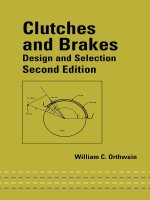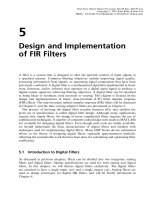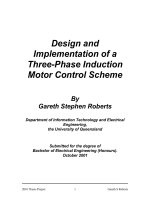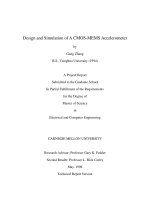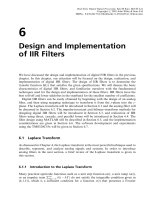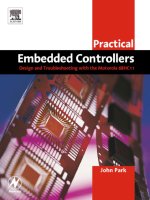batch distillation - design and operation
Bạn đang xem bản rút gọn của tài liệu. Xem và tải ngay bản đầy đủ của tài liệu tại đây (19.98 MB, 417 trang )
ABOUT THE AUTHOR
Dr.
I.M. Mujtaba
is
a
Senior Lecturer in Chemical Engineering in the School
of
Engineering, Design
&
Technology at the University of Bradford and is a member
of
the University Senate. He is a Fellow of the IChemE, a Chartered Chemical
Engineer and is currently the Secretary of the IChemE’s Computer Aided Process
Engineering Subject Group.
Dr. Mujtaba is actively involved in many research areas like: dynamic
modelling, simulation, optimisation and control of batch and continuous chemical
processes with specific interests in distillation, industrial reactors, refinery processes
and desalination. He has published more than
50
technical papers
in
major
Engineering Journals, International Conference Proceedings and Books. He is a co-
editor
of
the book
“Application
of
Neural Networks and Other Learning
Technologies in Process Engineering”
published by the Imperial College Press,
London in
2001.
He has several ongoing research collaborations and consultations
with
industries and academic institutions in the
UK,
Italy, Hungary, Malaysia and
Thailand.
Dr. Mujtaba obtained his BSc in 1983 and MSc in 1984 all in Chemical
Engineering from the Bangladesh University
of
Engineering
&
Technology
(BUET).
He studied at Imperial College, London with the Commonwealth Scholarship and
received his PhD and DIC in 1989.
Dr. Mujtaba
was
a Lecturer and Assistant Professor at BUET during 1984-1990.
From 1990-1994 he worked as a Research Fellow at the Centre for Process Systems
Engineering, Imperial College, London.
SERIES ON CHEMICAL ENGINEERING
Series Editor:
Ralph
T.
Yang
(Univ.
of
Michigan)
Advisory
Board:
Robert
S.
Langer
(Massachusetts Inst. of Tech.)
Donald
R.
Paul
(Univ. of Texas)
John
M.
Prausnitz
(Univ. of California, Berkeley)
Eli Ruckenstein
(State Univ.
of
New
York,)
James Wei
(Princeton Univ.)
Vol.
1
Gas Separation by Adsorption Processes
Ralph T. Yang (Univ. of Michigan)
Vol.
2
Adsorption Analysis: Equilibria and Kinetics
Duong D. Do (Univ. of Queensland)
Series
on
Chemical
Engineering
Batch
Distillation
Design
and
Operation
I.M.
Mujtaba
University
of
Bradford,
UK
Imperial College
Press
Published by
Imperial College Press
57 Shelton Street
Covent Garden
London WC2H 9HE
Distributed by
World Scientific Publishing Co. Re. Ltd.
5 Toh Tuck
Link,
Singapore 596224
USA
office:
Suite 202,1060 Main Street, River Edge, NJ 07661
UK
office:
57 Shelton Street, Covent Garden, London WC2H 9HE
British Library Cataloguing-in-Publication Data
A catalogue record
for
this book is available from the British Library.
BATCH DISTILLATION
Design and Operation
Series on Chemical Engineering
-
Vol.
3
Copyright
0
2004 by Imperial College Press
All
rights reserved. This book,
or
parts thereoj may not be reproduced in any form
or
by any means,
electronic
or
mechanical, includingphotocopying, recording
or
any information storage
and
retrieval
system now known
or
to be invented, without written permission from the Publisher.
For photocopying of material in this volume, please pay
a
copying fee through the Copyright
Clearance Center, Inc., 222 Rosewood Drive, Danvers, MA 01923, USA. In this case permission to
photocopy is not required from the publisher.
ISBN 1-86094-437-X
Editor: Tjan Kwang Wei
Printed
in
Singapore
by
World Scientlfic Printers
(S)
Pte
Ltd
To
my parents: Professor
M.
Ishaque and Mrs.
R.
Ishaque
My
wife: Nasreen
And my children: Sumayya, Maria, Hamza and Usama
This page intentionally left blank
Foreword
Batch distillation process is around us for many centuries. It is perhaps the oldest
technology for separatinglpurifying liquid mixtures and is the most frequently used
separation method in batch processes. In batch distillation, the main concerns
(issues) for the researchers and process engineers in the last four decades were: (i)
the design of alternative and suitable column configurations, (ii) the development of
mathematical models in line with the development of numerical methods, (iii) the
formulation and solution of dynamic optimisation problems for optimal design,
operation and control, (iv) the development of off-cut recycling strategies, (v) the
use of batch distillation in reactive and extractive mode and most recently (vi) the
use of artificial neural networks in dynamic modelling, optimisation and control.
Although there are several books on distillation in general where batch
distillation is only briefly introduced, there is only one book currently available in
the market that is solely dedicated to Batch Distillation. It addresses some of the
issues mentioned above using short-cut methods, simplified models and Maximum
Principle based optimisation techniques and therefore is a good book to start with
for the undergraduate students and for the practitioners in process engineering whose
interests lie in the basics of batch distillation and in
the
preliminary design
of
batch
distillation columns and operations.
In the last
25
years, with continuous development of faster computers and
sophisticated numerical methods, there have been many published work that have
used detailed mathematical models with rigorous physical property calculations and
advanced optimisation techniques to address all the issues mentioned above. These
have been the motivating factors to write this book in which excellent and important
contributions of many researchers around the globe and those by the author and co-
workers are accommodated.
This
book
is structured in
12
chapters highlighting the major developments in
the last
25 years. Moreover, in comparison to the materials in the existing book on
batch distillation and the materials available in other distillation books, the new
materials included in this book are:
0
State Task Network (STN) representation of operating sequence for binary
and multicomponent batch distillation
0
Simple to detailed mathematical models for conventional and
unconventional batch distillation processes
0
Maximum Principle
to
sophisticated SQP based nonlinear optimisation
techniques
0
Short-cut to rigorous methods for optimal design and operation
0
Binary to multi-component off-cut recovery and optimal recycling
strategies.
vii
Batch Distillation
Vlll
0
Modelling and optimisation of batch reactive and extractive distillation
processes
0
Inverted, middle vessel and multivessel batch distillation column operations
Use of continuous distillation columns for batch distillation
Neural Network based hybrid dynamic modelling and optimisation
methods for conventional and unconventional column configurations
I
certainly believe that this book will be beneficial and will be a good reference
book for the undergraduate and postgraduate students, academic researchers, batch
processing industries, industrial operators, chemists and engineers for many years to
come.
Dr. Iqbal M. Mujtaba
Senior Lecturer in Chemical Engineering
School of Engineering, Design and Technology
University of Bradford, Bradford BD7 lDP, UK
Email:
September
2003.
Contents
FOREWORD
VII
ACKNOWLEDGEMENTS
XIX
1
.
INTRODUCTION
3
1.1. Batch Processes
3
1.2. Distillation
4
1.3. Continuous Distillation
4
1.4. Batch Distillation
5
1.5. Semi-batch (semi-continuous) Distillation
7
1.6.
Advantages of Batch DistiJlation
7
References
10
2
.
COLUMN CONFIGURATIONS
11
2.1.
~onventiona~ column Configuration
11
2.2. Unconventional co~umn Configurations
11
2.2.1.
Inverted Batch Distillation Column
11
2.2.2.
Middle
Vessel
Batch Distillation Column
12
2.2.3.
Multivessel Batch Distillation
Column
13
2.2.4.
Continuous Column
for
Batch Distillation
14
References
16
3
.
OPERATION
17
ix
X
Batch
Distillation
3.1. Representation
of
Operational Alternatives Using State Task Network
17
3.1.1. Binary Mixtures
18
3.1.2. Multicomponent Mixtures
20
3.2. Column Operation
22
3.2.2. Constant Condenser Vapour Load
23
3.2.3. Constant Distillate Rate
25
3.2.4. Constant Reboiler
Duty
25
3.2.5. Cyclic Operation
25
3.2.1. Constant Vapour Boilup Rate
22
3.3. Start.up. Production and Shutdown
25
3.3.1. Start-up Period
26
3.3.2. Product Period
26
3.3.3. Shutdown Period
27
3.3.4. Case Study
28
3.4. Performance Measure
33
3.4.1. Case Study- Experiment
Based
Algorithm for Minimum Time
34
3.5. Column Holdup
37
3.5.2. Performance Measure
-
Minimum Time
39
3.5.1. Column Characterisation- the Degree
of
Difficulty
of
Separation
38
3.5.3. Case Study
39
3.6.
Campaign Operation
49
3.7. Recycle Operation
51
3.7.1. Binary Mixture
51
3.7.2. Multicomponent Mixture
52
References
54
4
.
MODELLING AND SIMULATION
56
4.1. Introduction
56
4.1.1. Simulation of Start-up Period
56
4.1.2. Simulation
of
Product Period
57
Contents
xi
4.2.
Models
for
Conventional Batch Distillation
58
4.2.1. Rayleigh Model
.
Model Type
I
58
4.2.3. Simple Model- Model Type I11
63
4.2.4. Rigorous Model
-
Model Type
IV
68
4.2.2. Short-cut Model- Model Type
II
59
4.2.5.
Rigorous Model
with
Chemical Reactions
-
Model Type V
79
4.3.
Models
for
Unconventional Batch Distillation
85
4.3.1. Continuous Column
for
Batch Distillation 85
4.3.2. Inverted Batch Distillation (IBD) Column
88
4.3.3: Middle Vessel Batch Distillation Column (MVC)
96
4.3.4. Multivessel Batch Distillation Column (MultiBD)
103
4.4.
Packed Batch Distillation and Model
106
4.5.
Numerical Issues
107
4.5.1. Classification
of
ODES and
DAEs
107
4.5.2. Integration Methods
108
4.5.3.
Initialisation
of
the
DAE
System
111
Nomenclature
111
References
112
5
.
DYNAMIC OPTlMlSATlON
116
5.1.
Optimisation
116
5.1.1.
Essential Features
of
Optimisation Problems
116
5.2. Dynamic Optimisation (Optimal Control)
of
Batch Distillation
117
5.2.1.
Minimum Time Problem
119
5.2.2.
Maximum Distillate Problem
120
5.2.3.
Maximum ProfitProductivity Problem
121
5.3.
Summary
of
the Past
Work
on Dynamic Optimisation
122
5.4.
Summary
of
the Past
Work
on the Solution
of
Optirnisation Problems
124
5.5.
Maximum Principle Based Dynamic Optimisation Technique
124
xii
Batch Distillation
5.5.1. Application to Batch Distillation: Minimum Time Problem
126
5.5.2. Application to Batch Distillation: Maximum Distillate Problem
132
5.5.3. Application to Batch Distillation: Maximum Profit Problem
133
5.5.4. Application to Batch Distillation: Short-cut Model
134
5.6.
Approaches to Nonlinear Dynamic Optimisation Technique
135
5.6.1. Feasible Path Approach
135
5.6.2. Infeasible Path Approach
135
5.7.
Nonlinear Programming (NLP) Based Dynamic Optimisation Problem-
Feasibte Path Approach
136
5.7.1. Control Vector Parameterisation
(CVP)
137
5.7.2.
NLP
Optimisation Problem
138
5.8.
NLP Based Dynamic Optimisation Problem- Infeasible Path Approach
139
5.9.
Gradient Evaluation Methods in NLP Based Optimisation Techniques
140
5.9.1. Gradient Evaluation for Infeasible Path Approach
140
5.9.2. Gradient Evaluation for Feasible Path Approach
140
5.10.
Application of NLP Based Techniques in Batch Distillation
144
5.10.1. Example 1
144
5.10.2. Example 2
145
5.10.3. Example 3
147
References
150
6
.
MULTIPERIOD OPERATION OPTlMlSATlON
153
6.1.
Introduction
153
6.2.
Optimisation Problem Formulation- Mujtaba and Macchietto
155
6.2.1.
Binary Operation
156
6.2.2. Multicomponent Operation
160
6.3.
Solution Method
.
Mujtaba and Macchietto
164
6.3.1. Column Initialisation
164
Contents
xiii
6.3.2. Inner Loop Optimisation Problems
164
6.3.3. Outer
Loop Optimisation
Problem
165
6.4. Example Problems
168
6.4.1. Binary Distillation (Simple Model)
168
6.4.2. Ternary Distillation (Simple Model)
170
6.4.3. Ternary Distillation (Detailed Model)
176
6.4.4. Multiperiod Campaign Operation Optimisation
-
Industrial Case
Study
179
6.5. Optimisation Probiem Formulation- Farhat et a1
187
6.5.1. Problem
1
.
Maximisation of Main-cuts
187
6.5.2. Problem 2
.
Minimisation
of
Off-cuts
188
6.5.3. Example
189
References
191
7
.
DESIGN AND OPERATION OPTlMlSATlON
192
7.1.
Introduction
192
7.2.
Design and Operation Optimisation for Single Separation Duty by
Repetitive Simulation
193
7.2.1. Example
.
Single Separation Duty
199
7.3.
Design and Operation Optimisation for Single and Multiple Separation
Duties: Problem Formulation and Solution
199
7.3.1. Representation
of
Design. Operations
and
Separations Duties
200
7.3.2. Objective Function
204
7.3.3. Optimisation
Problem Formulation and Solution
205
7.3.4. Examples
212
7.4. Multiperiod Design and Operation Optimisation by
Logsdon
et
al
.
.
219
7.4.2,
Example 2.
220
7.4.3. Combination
of
Allocation Time
with
Zero Set up Time
222
7.4.1. Example 1
220
7.5.
Multiperiod Operation Optimisation by Bonny et
al
224
7.5.1. Example
227
xiv
Batch Distillation
References
229
8
.
OFF-CUT RECYCLE
.
230
8.1.
Introduction
.
Off-cut Recycle in Binary Separation
230
8.2.
Classical Two-Level Optimisation Problem Formulation for Binary
Mixtures
233
8.2.1. Example Problems
.
Set
1
236
8.2.2. Example Problems
-
Set 2
241
8.3.
One Level Optimisation Problem Formulation for Binary Mixtures
242
8.4.
Comparison of the
Two
Level and the One Level Formulations
243
8.5.
More Examples using the One Level Optimisation Formulation
244
8.6.
Notes on Binary Off-cut Recycle
246
8.7.
Introduction
.
Off-cut Recycle in Multicomponent Separation
247
8.7.1.
Operational Strategies for Off-cut Recycle
249
8.8.
Optimisation Problem Formulation for Multicomponent Mixtures
.
250
8.8.1. Solution of the Optimisation Problem
252
8.9.
Decomposition of the Optimisation Problem Formulation for
Multicomponent Mixtures
253
8.10.
Measure of "the degree
of
difficulty" of Separation.
q
for
Multicomponent Mixtures
256
8.11.
Example Problem using Multicomponent Mixtures
257
8.1
1.1.
Example
1
257
8.1
1.2. Example
2
262
8.12.
Multicomponent Off-cut Recycle Policy of Bonny et
al
263
8.12.1. Example
265
References
269
Contents
xv
9
.
BATCH REACTIVE DISTILLATION (BREAD)
270
9.1.
Introduction
270
9.2.
Review
271
9.2.2. Modelling
and
Simulation
272
9.2.3.
Design,
Control and Optimisation
272
9.2.1. Experimental Studies
271
9.3.
Selecting the Right
Column
for BREAD
273
9.4.
Process Modelling and Simulation
274
9.5.
Dynamic Optimisation
276
9.6.
Example: Dynamic Optimisation
277
9.7.
Profit Maximisation via Maximum Conversion Optidsation
282
9.7.1. Example
283
9.8.
Polynomial Based Optimisation Framework
.
A
New Approach
285
9.9.
Campaign Mode Operation Optimisation
289
9.9.1.
Example: Hydrolysis
of
Acetic
Anhydride
290
9.10.
Optimal Design
of
Operating Procedures with Parametric Uncertainty
9.10.1. The Worst-case Design Algorithm
293
9.10.2.
Case Study
294
293
References
300
10
.
BATCH EXTRACTIVE DISTILLATION (BED)
302
10.1.
Introduction
302
10.2.
Comparison Between a CBD and a BED Process
304
10.3.
Solvent Feeding Modes and Operating Constraints
304
xvi
Batch
Distillation
10.3.1. Batch Mode
304
10.3.2. Semi-continuous Mode
307
10.4.
Operational Constraint (Path Constraint)
309
10.4.1. One Time Interval
309
10.4.2.
Two
Time Intervals
309
10.5.
General Multiperiod Dynamic Optimisation (MDO) Problem
Formulation
311
10.6.
Product Specifications and Decomposition
of
MDO
Problem into
Single-period Dynamic Optimisation
(SDO)
Problems
313
10.6.1. Maximum Productivity Problem
314
10.6.2. Minimum Time Problem
315
10.7.
Process Model and the Solution Method
316
10.8.
Case Studies
317
10.8.1. Example 1: Minimum Time Problem
.
Close Boiling Mixture317
10.8.2. Example 2: Maximum Productivity Problem
-
Close Boiling
Mixture
324
10.8.3. Example 3: Multiperiod Optimisation with Azeotropic Mixture
326
References
329
11
.
UNCONVENTIONAL BATCH DISTILLATION
331
11.1.
Introduction
331
11.2.
Use
of
Continuous Columns for Batch Distillation
331
11.2.1. Introduction
331
11.2.2. SPSS, SPSSS,
MPSSS
Operations
334
11.2.3. Single Separation Duty
in
Continuous Columns
336
11.2.4. Case Study
-
Single Separation Duty
339
11.2.5. Multiple Separation Duties in Continuous Columns
346
11.2.6. Case Study
-
Multiple Separation Duties
347
11.2.7. Notes
on
the Use of Continuous Columns for Batch Distillation
350
Contents
xvii
11.3. Middle Vessel Batch Distillation Column (MVC)
351
11.4. Inverted Batch Distillation (IBD) Column
353
11.4.1. Example
1
353
11.4.2. Example 2
354
11.5.
Multi Vessel Batch Distillation Column (MultiBD)
355
11.5.1. Optimisation Problem Formulation
355
11.5.2. Example
359
References
363
12
.
APPLICATION
OF
NEURAL NETWORKS IN BATCH DISTILLATION365
12.1. Introduction
365
12.1.1. Neural Networks Architecture
366
12.1.2. Neural Networks Training
367
12.2. Hybrid Modelling and Optimisation in CBD
367
12.2.1. The Model and the Actual Process
368
12.2.2. Hybrid Modelling
of
Dynamic Processes
369
12.2.3. Dynamic Optimisation Framework Using First Principle Model 37 1
12.2.4. Dynamic Optimisation Framework Using Hybrid Model
371
12.2.5. Hybrid Model Development
for
Pilot Batch Distillation Column373
12.2.6.
NN
Based Optimisation Algorithm
377
12.3.
NN
Based Modelling and Optimisation in
MVC
379
12.3.1. Neural Network Based Modelling
379
12.3.2. Optimisation Problem Formulation
385
12.3.3. Results and Discussions
386
References
391
INDEX
393
This page intentionally left blank
Acknowledgements
Alhamdulillah- all praises be to almighty Allah who made it possible for me to write
this book.
About sixty percent of our own work included in this book was carried
out
during my stay at the Imperial College London in the Department of Chemical
Engineering and in the Centre for Process Systems Engineering (CPSE) between
1985 and 1994.
I
am greatly indebted to Professor Sandro Macchietto who was very
kind to accept me as his PhD student in 1985 and allowed me to work with him until
1994. He greatly influenced and motivated me to explore batch distillation in depth.
I
owe to Professor Pantelides for his generous help and support in mathematical
modelling and advanced numerical methods.
I
am grateful
to
Professor Sargent and
Professor Perkins (ex directors) for allowing me to work at the CPSE from 1990 to
1994.
I
would like to express my gratitude to Dr. Chen who helped me in great deal
in understanding and learning SQP based optimisation techniques. Finally,
I
would
like to acknowledge sincerely the financial support provided by the ACU during
1985-1988 in the form of Commonwealth Scholarship to carry out the research in
batch distillation.
The remaining forty percent of our own work included in this book was carried
out at the University of Bradford during 1995-2002. I am grateful to Professor
Bailes, Professor Benkreira and Dr.
Slater for their continuous support and
motivation in
my
work on batch distillation. I owe to Professor Coates for his
encouragement to get on with this book and complete it as soon as possible. The
continuous supports to my batch distillation research by Professor Macchietto,
Professor Pantelides and the Process Systems Enterprise (PSE) Ltd. during 1995-
2002 are gratefully acknowledged.
Some
of
the materials included in this book are due to international
collaborations with the University of Malaya (Malaysia) and the University
of
Padova (Italy). Dr. Hussain (University of Malaya) influenced and motivated me in
applying Neural Network Techniques in dynamic modelling and optimisation,
I
am
grateful for his support.
I
would like to thank Professor Barolo (University of
Padova) for his involvement in the work on MVC columns and for inviting me to
Padova to give lectures on recent developments in batch distillation in 1997.
I
would
like to acknowledge the UK Royal Society for the financial supports to carry out the
collaborative work with Dr. Hussain (Malaysia) since 1999 and Professor Perkins
for his kind support in the process. In this regard, I am also grateful to Professor Day
(Dean) for supporting me to continue my research collaboration with Malaysia.
Special thanks are due to Professor Urmila Diwakar (University of Illinois at
Chicago, USA), Dr. Eva Sorensen (UCL, London), Dr. Peter Lang (Technical
University Budapest, Hungary) and Dr. Ben Betlem (University of Twente,
Netherlands) for many useful technical discussions in the past.
I
would also like to
xix
XX
Batch Distillation
thank my past and current postgraduate students and post-doc researchers
Dr.
Greaves, Mr. Tran, Mr. Avignon, Mr. Miladi, Mr. Magbary and Dr. Milani for their
contributions in some of the work presented in this book.
Most of our own work included in this book is computational and
I
owe to a
large extent to: (a) late Dr. John Flower of the University of Leeds who encouraged
me in computational research during his visit to Bangladesh University of
Engineering
&
Technology (BUET) in 1984 and (b) Professor
J.
Zaman who taught
me the basics of batch distillation, computer programming and supervised my MSc
research project on process modelling and simulation.
I
am also grateful to Professor
N. Ahmed, Professor
I.
Mahmud, Professor K. Rahman, Professor A.K.M.A. Quader
and Dr. T. Mahmud for teaching me, with great care, Separation Processes,
Transport Phenomena and Process Design at both undergraduate and postgraduate
levels at BUET during 1979-1984. All of them largely contributed in shaping
up
of
my research in batch distillation.
I
am indebted to my father Professor M. Ishaque (ex graduate
of
Imperial
College) and mother Mrs.
R.
Ishaque for encouraging me to study at Imperial
College, London and for their countless love and blessings throughout my life and
career.
I
owe to my wife Nasreen for her great support and continuous encouragement
in writing this book. Despite her fulltime work schedule as
a
social and community
worker, she freed me from my household commitments during the writing up of this
book. The wonderful time and fun
I
had with my children Sumayya, Maria, Hamza
and Usama during the research and writing
up
of this book deserve great
appreciations. It would be impossible to write this book without them around me.
Finally, special thanks are due to Imperial College Press, London for giving me
over
3
years to complete this book and for publishing it.
I
sincerely acknowledge
their support and help. Also
I
would like to thank all other publishing companies
(including organisations and societies) who have kindly granted me permissions to
reproduce some of the Tables and Figures in this book without which the
book
would be incomplete.
Batch Distillation:
Design and Operation
This page intentionally left blank
CHAPTER
1
1.
INTRODUCTION
1.1.
Batch
Processes
In
the 1950s, chemical engineers might have the impression that the ultimate
mission of the engineers was to transform old-fashioned batch processes into
modern continuous ones (Rippin, 1983). With such a perspective it is surprising to
find
that, today, fifty years later a significant proportion of the world’s chemical
production by volume and a much larger proportion by value is still made in batch
plants and it is unlikely that this proportion will decline in the near future.
Parakrama (1985) reported that 99 batch processes were in operation
in
74
UK
manufacturing companies. Among these, 80% plants were producing chemicals in
steady
or
growing markets. Moreover, many more products, which could be
manufactured continuously, are in fact made in batch plants
on
economic grounds
(Rippin, 1991).
Batch production is usually carried out in relatively standardised types
of
equipment, which can easily be adapted and if necessary reconfigured to produce
many other different products. It is particularly suitable for low volume, high value
products such as pharmaceuticals, polymers, biotechnologicals or other fine
chemicals for which annual requirement can be manufactured in few days or few
batches in an existing plant. The flexibility of the production arrangements can also
cope with the fluctuations or rapid changes in demand, which
is often characteristic
of products
of
this type. Other factors (Shah, 1992) which favours batch processing
are:
increased global competition in the bulk chemicals sector
need to produce customer specific products
seasonal
demands of certain products
Where small amounts of different products must be produced, it is usually more
economically efficient to manufacture them in a common facility such as
multipurpose batch plant, rather than operating one plant per product.
3
4
Batch Distillation
1.2.
Distillation
Distillation separates two or more liquid components in a mixture using the
principle of relative volatility or boiling points. The greater the difference in relative
volatility the greater the nonlinearity and the easier it is to separate the mixture
using distillation. The process involves production of vapour by boiling the liquid
mixture in a still and removal of the vapour from the still by condensation. Due to
differences in relative volatility or boiling points, the vapour is rich in light
components and the liquid is rich in heavy components.
Often a part of the condensate is returned
(reflux)
back to the still and is mixed
with the outgoing vapour. This allows further transfer of lighter components to the
vapour phase from the liquid phase and transfer of heavier components to the liquid
phase from the vapour phase. Consequently, the vapour stream becomes richer in
light components and the liquid stream becomes richer in heavy components.
Different types of devices called plates, trays or packing are used to bring the
vapour and liquid phases into intimate contact to enhance the mass transfer.
Depending on the relative volatility and the separation task (i.e. purity of the
separated components) more
trays
(or more packing materials) are stacked one
above the other in a cylindrical shell to form a
column.
The distillation process can be carried out in
continuous, batch
or in
semi-batch
(or semi-continuous)
mode.
1.3.
Continuous Distillation
Figure 1.1 shows a typical continuous distillation column. The liquid mixture
(feed),
which is to be separated into its components, is fed to the column at one or more
points along the column. Liquid runs down the column due to gravity while the
vapour runs up the column. The vapour is produced by partial vaporisation
of
the
liquid reaching the bottom of the column. The remaining liquid is withdrawn from
the column as
bottom product
rich in heavy components. The vapour reaching the
top
of
the column
is
partially or fully condensed. Part of the condensed liquid is
refluxed
to
the column while the remainder is withdrawn as the
distillate product.
The column section above the feed tray rectifies the vapour stream with light
components and therefore is termed
as
rectlfying
section. The column section below
the feed tray strips heavy components from the vapour stream to the liquid stream
and is termed as
stripping
section.
The readers are directed to Smith (1963), Seader and Henley (1998), Perry et al.
(1997), McCabe et al. (2001), Gani and co-workers (1986a, 1986b, 1988,
2000),
